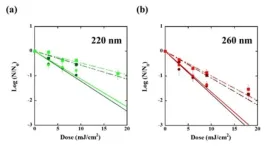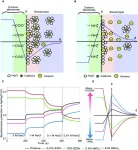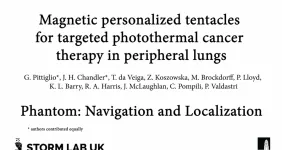(Press-News.org) INDIANAPOLIS – Accessing neurologic care often presents physical, geographical and financial challenges to patients, many of whom face chronic and disabling conditions. With a nationwide scarcity of neurologists in the U.S., especially in rural areas, disparities in access to timely neurological assessment and treatment are not uncommon. Telehealth addresses access to care as well as other inequity issues.
To meet the need for prompter care and to diminish disparity for rural veterans, the U.S. Department of Veterans’ Affairs (VA) National Teleneurology Program was funded in 2019 by the VA’s Office of Rural Health. The program is a patient-centered, flexible, cost-effective virtual hub model that uses synchronous (video) and asynchronous technologies.
In one of the first and largest studies of outpatient general teleneurology care, a research team, led by Linda S. Williams, M.D., a VA and Regenstrief Institute clinician-researcher, evaluated the innovative program which serves patients with many common conditions including headache, seizures, multiple sclerosis, recent stroke and back pain.
The researchers studied the impact the teleneurology program had on the timeliness of access to neurological care, as well as the program’s effect on the volume of veteran neurology consultations completed outside the VA system — the only option for most veterans prior to this new program.
“Telehealth is one way that the VA helps veterans receive care wherever they are. They don't even have to leave their home,” said Dr. Williams. “And this is very important for some patients with conditions like epilepsy that can make driving difficult and for older patients, who may struggle to drive to a larger city that has a neurologist.
“In the VA teleneurology program, clinicians saw many common neurological problems analogous to those seen in any general neurology clinic. I think our results are likely applicable to non-VA teleneurology programs, although the VA has a very robust infrastructure for teleneurology care and for telehealth care in general, unlike many health systems,” said Dr. Williams.
The researchers compared wait times for appointments at VA sites that had implemented telecare for general neurology patients versus sites that had not yet implemented it and found shorter wait times for telehealth appointments than in-person visits. They also investigated wait times for eligible veterans to receive appointments with a community neurologist due to inability to receive an in-person appointment with a VA clinician. The researchers found that sites which had implemented the teleneurology program did not see a rise in the volume of community care requests in the year after program implementation and that wait time for teleneurology was significantly less than wait times for an appointment with a community neurologist. Sites that did not implement telehealth for chronic neurologic conditions had a significant increase over time in the monthly number of community care neurology consults they placed.
Since passage by Congress of the Mission Act of 2018, veterans living more than 60 miles from a VA facility or those who must wait more than 28 days to receive care from a VA clinician are eligible to receive that care in the community. However, wait time for an appointment with a community neurologist is often quite long, especially in rural areas, where only about 3 percent of U.S. neurologists practice. Four out of five rural counties in the U.S. do not have at least one neurologist.
“When you implement a new program, you need to ask: Does it really make a significant difference in the outcome that you're trying to reach,” notes Dr. Williams. "With this program we were trying to improve the speed at which veterans could receive neurologic care, and we were also trying to understand, from the healthcare system perspective, whether implementing this new telehealth program really made a dent in the community care volume that the VA has been sending out to non-VA physicians, which has been increasing over the past few years.”
The authors conclude, “As the mismatch between the proportion of the population with neurologic conditions and the number of neurologists grows, Teleneurology outpatient care, as demonstrated by NTNP [VA National Tele-neurology Program], is one means of improving patient access to neurologic specialists. This care overcomes some important barriers to access, including rural residence and scarcity of local neurologists, and can be provided with high satisfaction among patients and their referring primary care providers. Although little randomized trial evidence exists to assess the efficacy of telehealth care for chronic conditions, and most of this literature is in patients with diabetes, our study suggests that Teleneurology care not only improves access to care but is feasible and acceptable to patients; future studies should assess the efficacy of Teleneurology care compared to in-person care for ongoing management of patients with neurologic conditions.”
“The VA National Teleneurology Program (NTNP): Implementing Teleneurology to improve equitable access to outpatient neurology care” is published in Journal of General Internal Medicine (JGIM).
The TeleNeurology evaluation was funded by the VA Office of Rural Health.
Authors and affiliations:
Jayne Wilkinson, M.D.1,2; Laura Myers, PhD3; Joanne Daggy, PhD3,4; Holly Martin, MPH3,5; Grace Bastin, B.S.3; Ziyi Yang, M.S.4; Teresa Damush, PhD3,5,6; Aditi Narechania, M.D.7-9; Steve Schriber, M.D.10,11; and Linda S. Williams, M.D.3,5,12
1 Corporal Michael J Crescenz VAMC;
2 Department of Neurology, University of Pennsylvania;
3Richard L. Roudebush VAMC HSR&D EXTEND QUERI;
4Indiana University School of Medicine, Department of Biostatistics;
5Regenstrief Institute, Inc;
6Indiana University School of Medicine, Department of Medicine;
7Jesse Brown VAMC;
8University of Illinois Chicago;
9Northwestern University,
10Tibor Rubin VAMC;
11University of California, Irvine;
12Department of Neurology, Indiana University School of Medicine
About Linda S. Williams, M.D.
In addition to her role as a research scientist with the William M. Tierney Center for Health Services Research at Regenstrief Institute, Linda S. Williams, M.D., is a core investigator for the U.S. Department of Veterans Affairs Health Services Research and Development Center for Health Information and Communication and a co-principal investigator for the VA HSR&D Expanding Expertise through e-health Network Development (EXTEND QUERI) at Richard L. Roudebush VA Medical Center. She also is a professor of neurology at Indiana University School of Medicine.
About Veteran Health Indiana and CHIC
The Richard L. Roudebush VA Medical Center is the flagship medical center for Veteran Health Indiana, the VA’s healthcare system in central and southern Indiana. The medical center is located in downtown Indianapolis and is collocated with three large community hospitals and the campus of the Indiana University Schools of Medicine and Nursing. The health system has been serving Hoosier Veterans since 1932. As Indiana’s Level 1a, tertiary care Veteran facility and one of only two VHA facilities in the nation to have Joint Commission Stroke Care Certification, the medical center serves as home base for a system of inpatient and outpatient care locations serving more than 62,000 Veterans.
The VA Health Services Research and Development (HSR&D) Center for Health Information and Communication (CHIC) group is a diverse cadre of researchers based at Roudebush VA Medical Center who work together to transform the healthcare system, both within and outside the VA so every patient receives consistent, high-quality care.
About Regenstrief Institute
Founded in 1969 in Indianapolis, the Regenstrief Institute is a local, national and global leader dedicated to a world where better information empowers people to end disease and realize true health. A key research partner to Indiana University, Regenstrief and its research scientists are responsible for a growing number of major healthcare innovations and studies. Examples range from the development of global health information technology standards that enable the use and interoperability of electronic health records to improving patient-physician communications, to creating models of care that inform practice and improve the lives of patients around the globe.
Sam Regenstrief, a nationally successful entrepreneur from Connersville, Indiana, founded the institute with the goal of making healthcare more efficient and accessible for everyone. His vision continues to guide the institute’s research mission.
About IU School of Medicine
IU School of Medicine is the largest medical school in the U.S. and is annually ranked among the top medical schools in the nation by U.S. News & World Report. The school offers high-quality medical education, access to leading medical research and rich campus life in nine Indiana cities, including rural and urban locations consistently recognized for livability.
END
Study addresses use of teleneurology to improve access to outpatient care, other inequity issues
One of largest national implementations of telehealth for chronic neurologic conditions
2023-07-27
ELSE PRESS RELEASES FROM THIS DATE:
UV disinfection in the treatment management of SARS-CoV-2 Omicron variants
2023-07-27
The global outbreak of severe acute respiratory syndrome coronavirus 2 (SARS-CoV-2) and its new variants has created a need for effective disinfection technologies to protect against harmful pathogens. While vaccines offer some protection, their effectiveness against future variants is uncertain. Therefore, additional strategies are important during the pre-vaccine stage.
UV irradiation has lately emerged as a safe, effective, and convenient strategy to inactivate and eliminate disease-causing micro-organisms. The wavelength range of 200-235 ...
Fullerene-pillared porous graphene with high water adsorption capacity
2023-07-27
Separation processes are essential in the purification and concentration of a target molecule during water purification, removal of pollutants, and heat pumping, accounting for 10–15% of global energy consumption. To make the separation processes more energy efficient, improvement in the design of porous materials is necessary. This could drastically reduce energy costs by about 40–70%. The primary approach to improving the separation performance is to precisely control the pore structure.
In this regard, ...
Tuning surface molecular design of porous carbon for blue energy harvesting
2023-07-27
Did you know rivers carry about 40 trillion metric tons of river water into the ocean every year? This meeting point, known as the estuary, holds great potential for electricity generation. Mixing the two types of water -- seawater and river water containing different salt concentrations -- releases a substantial amount of Gibbs free energy, which can be converted to electricity using semipermeable membranes. However, the performance of membranes has limited the economic viability of membrane-based approaches, leaving the vast potential of this naturally abundant energy source largely untapped.
To overcome the challenges associated with the membranes, researchers have developed membrane-free ...
New research reveals historic migration’s link to present-day implicit racial bias
2023-07-27
Roughly six million Black people moved away from the American South during the Great Migration between 1910 and 1970, hoping to escape racial violence and discrimination while pursuing economic and educational opportunities. Now, research has uncovered a link between this historic event with present-day inequalities and implicit biases.
In a new Social Psychological and Personality Science article, researchers report that current implicit bias among White people at the county-level is associated with the proportion of Black residents living in that county during the Great Migration (circa 1930). The research supports the Bias ...
Sri Lanka floods easier to predict with India weather tool
2023-07-27
Floods and landslides in Sri Lanka could be better predicted by applying weather forecasting techniques currently used in India, a study has found.
The new research has the potential to help communities better prepare for extreme rainfall in Sri Lanka. The South Asian island is extremely vulnerable to floods and landslides caused by heavy rainfall. In May 2017, more than 150 people were killed after Sri Lanka experienced flooding triggered by monsoon rains.
Led by Dr Akshay Deoras and published today (Thursday, 27 July) in Geophysical Research Letters, the study expands the ...
Study highlights importance of quality and potency of saw palmetto extracts in prostate health supplements
2023-07-27
A new study published in the Journal of Urology Open Plus reveals that 7 saw palmetto products met the identity and potency standards to effectively address urinary tract symptoms associated with an enlarged prostate. According to the lead author of the study, Dr. Bilal Chughtai, who is a board-certified urologist, of the 28 supplements included in the study, only six of the lipid extracts and one multi-active product were found to have the appropriate dosage of 320 milligrams of saw palmetto extract and the minimum 80% fatty acids clinically shown to address ...
New app developed at NYU Tandon School of Engineering promises to make navigating subway stations easier for people with blindness and low vision
2023-07-27
A new trip-planning app has shown encouraging results in improving navigation inside subway stations, according to a study published in IEEE Journal of Translational Engineering in Health and Medicine, promising the possibility of easier commutes for people who are blind and low-vision.
Designed by researchers at NYU Tandon School of Engineering and NYU Grossman School of Medicine, Commute Booster routes public-transportation users through the “middle mile” – the part of a journey inside subway stations or other similar transit hubs – in addition to the “first” and “last” miles that bring travelers to and from those hubs.
“The ...
New research shows potential role for mangos in supporting vascular health and antioxidant activities
2023-07-27
Boston - July 27, 2023 - Mangos are one of the most popular fruits1 in the world, grown in more than 100 countries2 globally and consumed by an extremely diverse population. Now, two new studies funded by the National Mango Board and presented as posters during the American Society for Nutrition’s Annual Conference (Nutrition 2023) show mangos may play a role in risk reductions for vascular issues while helping to improve antioxidant levels among relatively healthy adult men and women who are overweight ...
James Webb Space Telescope sees Jupiter moons in a new light
2023-07-27
With its sensitive infrared cameras and high-resolution spectrometer, the James Webb Space Telescope (JWST) is revealing new secrets of Jupiter's Galilean satellites, in particular Ganymede, the largest moon, and Io, the most volcanically active.
In two separate publications, astronomers who are part of JWST's Early Release Science program report the first detection of hydrogen peroxide on Ganymede and sulfurous fumes on Io, both the result of Jupiter's domineering influence.
"This ...
Tiny surgical robots could transform detection and treatment of cancers
2023-07-27
The ultra-soft tentacle, which measures just 2 millimetres in diameter and is controlled by magnets, can reach some of the smallest bronchial tubes and could transform the treatment of lung cancer.
It paves the way for a more accurate, tailored, and far less invasive approach to treatment and has been developed by engineers, scientists and clinicians based at the STORM Lab in Leeds.
The researchers tested the magnetic tentacle robot on the lungs of a cadaver and found that it can travel 37% deeper than the standard equipment and leads to less tissue damage.
The results ...
LAST 30 PRESS RELEASES:
Review article | Towards a Global Ground-Based Earth Observatory (GGBEO): Leveraging existing systems and networks
Penn and UMich create world’s smallest programmable, autonomous robots
Cleveland researchers launch first major study to address ‘hidden performance killer’ in athletes
To connect across politics, try saying what you oppose
Modulating key interaction prevents virus from entering cells
Project explores barriers to NHS career progression facing international medical graduates
Jeonbuk National University researchers explore the impact of different seasonings on the flavor perception of Doenjang soup
Two Keck Medicine of USC Hospitals named Leapfrog Top Teaching Hospitals
World-first discovery uncovers how glioblastoma tumours dodge chemotherapy, potentially opening the door to new treatments
A fatal mix-up: How certain gut bacteria drive multiple sclerosis
New AI tool identifies not just genetic mutations, but the diseases they may cause
Deep-learning model predicts how fruit flies form, cell by cell
Combination pills for high blood pressure may simplify treatment, improve long-term health
Immune system keeps mucosal fungi in check
Neurons within the brain use simple rules to localize genetic messages
Electrodes created using light
Second-hand gift-giving is a well-deliberated decision
How human interaction drove evolution to make bears less aggressive
National Poll: Few parents offer teens guidance on healthy eating during holiday season
Cannabis derivatives could provide new ovarian cancer treatments
Raising strong yeast as a petroleum substitute
Clues to the origin of hot Jupiters hidden in their orbits
Canada’s reduced pledge to Global Fund will impact domestic health
1 in 4 children with major traumatic injuries not cared for in pediatric trauma centres
Duke and Duke-NUS’ joint cross-population research to uncover "East-West" differences in disease and care
Scientists to ‘spy’ on cancer- immune cell interactions using quantum technology breakthrough
Tech savvy users have most digital concerns
Making lighter work of calculating fluid and heat flow
Normalizing blood sugar can halve heart attack risk
Lowering blood sugar cuts heart attack risk in people with prediabetes
[Press-News.org] Study addresses use of teleneurology to improve access to outpatient care, other inequity issuesOne of largest national implementations of telehealth for chronic neurologic conditions





